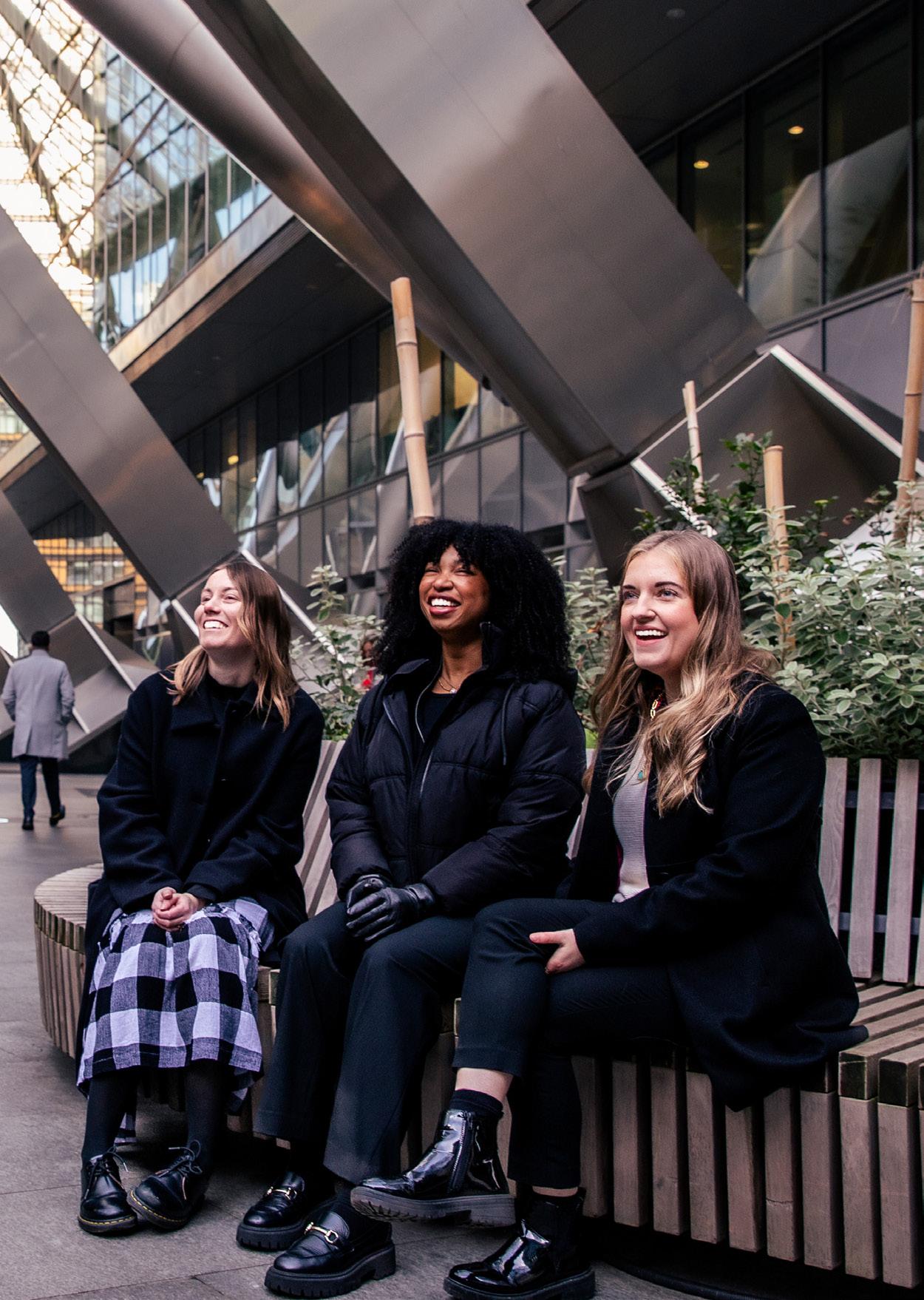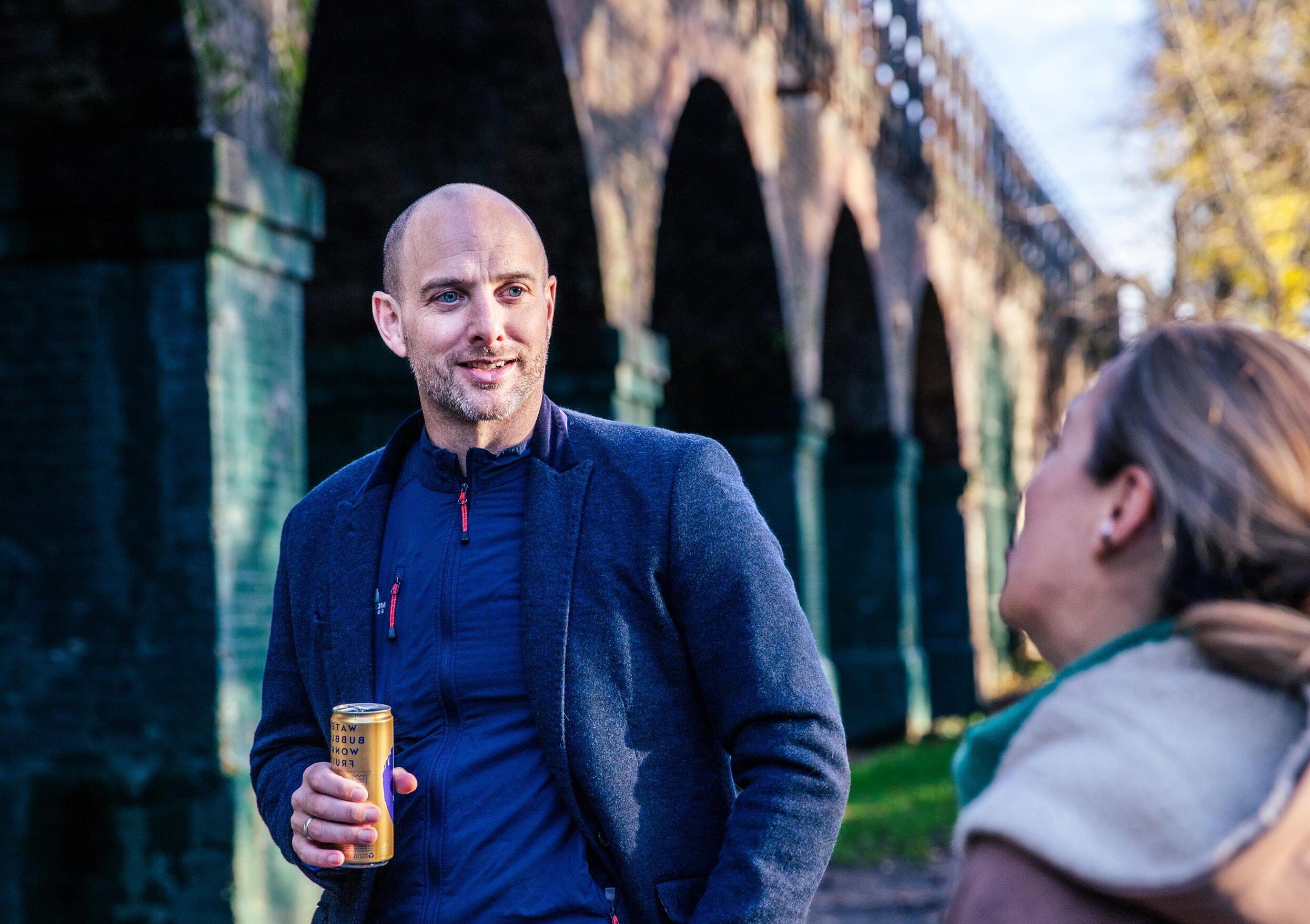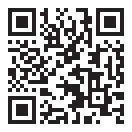10
INSIGHTS
ON COLLABORATIVE VS INDIVIDUAL LEARNING

LEARNING THAT’S WORKING FOR BOTH THE INDIVIDUAL AND THE GROUP
Most of us work in teams. So why do we tend to learn individually?

In fast-paced workplaces, we’re looking for ever-quicker ways to boost our skills. The advancements of AI tools have only expedited the expectation that learning should be ondemand, at the click of a button, delivered in seconds. Microlearning resources have given us this incredible power to learn ‘on tap’. Yet we also know the power of experiential learning. The buzz of a cohort. The unequivocal understanding that comes from practice with others. Employees love a personalised and collaborative approach.
When should our learning initiatives be a solo journey and when should we grow together?
Collaborative vs Individual Learning
INTRODUCTION
2 3
10 TEAMS THAT LEARN TOGETHER, CHANGE TOGETHER
COLLABORATIVE LEARNING INSPIRES A UNIFIED APPROACH; INDIVIDUAL LEARNING INSPIRES PERSONAL ACTION.
Unified approaches and personal actions are both useful outcomes from a learning experience. Team change tends to be more powerful than individual change (for the organisation at least), yet we can overlook the business impact of bringing people together to learn. A team can only change together by being together. On the other hand, there’s some level of personal investment necessary to be able to contribute effectively to the wider team. Individual learning can help each person identify how change in one part contributes to the transformation of the whole. Collaborative learning slots the pieces together.

The Prosci Methodology integrates the individual and organisational change management approaches necessary to achieve intended benefits from change projects and initiatives. It includes the ADKAR Model (individual), Prosci 3-Phase Process (organisational).
Source: Prosci
Coaching Question
What kind of desired organisational change would require unity? What would require individuality?
R 5 4
9 WE CAN UNLOCK HIGHLY INDIVIDUAL SELF-REFLECTION, BUT ALSO RELY ON UNIVERSAL TRUTHS
COLLABORATIVE LEARNING USES UNIVERSAL PRINCIPLES; INDIVIDUAL LEARNING OPTS FOR PERSONAL APPLICATION.
Self-reflection is great. Personal application is great too. But not everything has to be tailored to a specific people type and delivered by an AI. Some universal principles, many unchanging for years or decades, offer rich learning for a whole team without the need for personalisation. These same scientifically-backed principles can then give us the springboard for that personal application. Applied through a team, we’re able to contextualise the insight together for maximum impact, but applied individually, we’re also able to contextualise the insight to our personal experience for maximum understanding.
Key stat:
A study by Oak Engage of over 1000 UK employees indicated that 39% of employees were sceptical about significant organisational change but open to being shown by managers or colleagues why it was a good thing.
Source: Oak Engage, Change Report

Coaching Questions
What does it pay to rely on reflection over facts?
6 7
WE CAN GO FAST, OR WE CAN GO TOGETHER
COLLABORATIVE LEARNING FORCES STRONGER TEAM MEMBERS TO COLLABORATE; INDIVIDUAL LEARNING ALLOWS STRONGER TEAM MEMBERS TO ACCELERATE TO A HIGHER LEVEL.
As the idiom goes, “If you want to go fast, go alone. If you want to go far, go together.” Not all team members are created equal. Some are exceptionally high performers. Some just joined the company. Some are in entry-level roles, and some have been doing this for decades. This diversity means that the highest performers, if given a highly tailored, individual experience, will rocket ahead to their own level. On one hand, this is perfect if we’re looking to increase competencies at every level. But most failing teams don’t fail through a breakdown in competence; they fail by a breakdown in collaboration. Team-based learning encourages the high performers not to rush ahead, instead using their capabilities and experience to inspire performance across the team.
Key stat: A study by Mellisa Srougi and Heather Miller focused on pairing Chemistry students with dissimilar maths skills to assess impact on performance.
Students were split into two groups: one group selfselected their pairs; the other group were placed in assigned pairs based on entrance exam scores. They were divided into quartiles and laboratory partners were assigned so that 1st and 4th quartile scorers were partnered together, as were 2nd and 3rd.
Students who were assigned math partners of different ability showed an 8% improvement in chemistry math concepts compared to no improvement among those who self-selected a partner, as assessed using pre- and post-math tests.
Source: Mercer
Coaching Questions
In what areas\skills might it help to ‘hold someone back’ in the name of collaboration?
8 9 8
7 WE TEND TO BE LIMITLESS IN DEPTH OVER LIMITLESS IN BREADTH
COLLABORATIVE LEARNING CAN SCALE ITS AUDIENCE; INDIVIDUAL LEARNING CAN SCALE ITS COMPLEXITY.
Often we prioritise offering the right level for the right person. Choose your difficulty. Customisable to any individual. This can make for a brilliant learning resource. But we could also flip it to ask, “What’s the most valuable thing we could learn at breadth (i.e. with the whole team in the room)? How would we spend a half day together? What would we want to achieve or decide or connect or create?” This gives us two great routes; tailor everything to the right level of depth, or find the common denominator that the entire team can embrace for greater scalability and breadth of impact.
Key data: In a recent study conducted by researchers from the University of Washington, active learning driven by collaboration and interaction was proven to positively affect the academic performance of university students. They found:
• Active learning leads to increases in examination performance that would raise average grades by half a letter. (eg. A to A+)
• Students taught by traditional lecturebased learning are 1.5 times more likely to fail than students participating in courses featuring active learning.

Source: University of Washington
Coaching Question
What would be the most valuable outcome from having the whole team/department/ organisation in the room?
10 11
6
TEAMS THAT LEARN TOGETHER, PERFORM TOGETHER
COLLABORATIVE LEARNING USES HUB-STYLE ACCOUNTABILITY; INDIVIDUAL LEARNING USES SCRUM-STYLE AGILITY.
When we learn by ourselves, there’s a process (or lack of process) in sharing back this learning. When everyone was in the (virtual or physical) room, it’s easy. We all remember what we learnt, discussed, agreed, decided. Whilst individually we can organically share learnings as we see fit, group learning experiences have an in-built accountability between team members, which we know is a component of high-performing teams. If we want high performers, individual learning will do the job. But if we want high-performing teams, it’s only natural that the best way to accelerate a team is to learn together.
Coaching Question
Are we aiming to get more accountable or more agile?
Performance Impact Team Effectiveness Working Group PseudoTeam Potential Team Real Team High Performing Team 12 13
5 IT’S EASY TO CONFUSE INCLUSIVITY WITH INDIVIDUALITY
COLLABORATIVE LEARNING TENDS TO BE EXCLUSIVELY DESIGNED AND INCLUSIVELY DELIVERED; INDIVIDUAL LEARNING TENDS TO BE INCLUSIVELY DESIGNED, EXCLUSIVELY DELIVERED.
Learning delivered to an individual, or tailored to a particular group and delivered individually, may address the specific needs of that group, but it also excludes them from the wider team conversation. There’s so much to learn from bringing diverse voices into the same room. “That works differently for me/ for us.” “That might work in general, but here’s the nuance for me and people like me...” “I struggle with that because…” “I find this approach works for me…” These conversations are best drawn out between the team, in the moment of learning together. Otherwise, it’s only our learning journey that becomes inclusive, rather than our teams.
Key stat: According to a six-year study by McKinsey, diverse companies are 36% more profitable than less diverse companies.
Source: McKinsey

Coaching Question
What topics benefit most from hearing different perspectives?
14 15
4 WE TEND TO FORGET THE BUZZ OF REAL COLLABORATION
COLLABORATIVE LEARNING SAYS, “IT’S NOT GOOD TO BE ALONE”; INDIVIDUAL LEARNING SAYS, “MY BIGGEST PROBLEM IS OTHER PEOPLE.”
When asked about the main challenge that they were facing at work, one of our team famously replied, “Other people.” Even though we’re ‘people people’, it’s likely we’ve all thought our job would be easier if not for ‘other people’. Look to the BBC show The Apprentice for an illustration of how a simple task for a professional project manager, when given a team of egos to bring with them, becomes a nightmare. Yet we can’t seem to live with or without these things we call colleagues. We can’t go alone (not for long anyway). Collaboration is one of the biggest business buzzwords. We forget that, done properly (rather than slapped on the wall as a company value), collaboration gets the brain firing, the chemicals flowing, brings success greater than the sum of the parts, and makes us happier.
Key data:
Survival State Emotional State Executive State
BRAIN STEM
Survival state represents the base level of brain state, and asks the question “Am I safe?” The only way to soothe the Survival State is through the creation of safety.
LIMBIC STEM
This Brain State represents mid-level functionality and asks the question, “Am I loved?” The only way to soothe an upset emotional state is through connection.
PREFRONTAL LOBES
The Executive State represents the optimal state for problem-solving and learning. This Brain State asks the question, “What can I learn from this?”
Coaching Question
What experience could you describe that represents real collaboration to you?
16 17
3 WE OFTEN WANT TO MAXIMISE OUR TIME, NOT OUR LEARNING
COLLABORATIVE LEARNING IS LEARNING-PACED; INDIVIDUAL LEARNING IS LEARNER-PACED.
It might sound obvious, but there’s a distinct difference in the pacing of team-based versus individual learning. Sometimes learner-led pace is a good thing — individually, we slow it down to grasp a challenging concept and speed up for ground we’ve already covered. Sometimes though, it’s better facilitated, placing the job of timekeeping in the hands of a professional to keep us moving when unnecessarily slow, or slow us down where we’d rush ahead and miss out on proper application if left to our own devices. Ultimately, we want effective learning, not just efficient learning time.
Key stat: Research by cognitive psychologists Fernand Gobet and Guillermo Campitelli found that there were significant differences in the number of hours of practice it took chess players to reach a specific skill level. The number of hours to reach ‘master’ status ranged from 728 hours to 16,120 – meaning some players needed 22x more practice hours than others to reach the same skill level. One of the flaws with the common rule of thumb, the ‘10,000 hour rule’ (the idea it takes 10,000 hours invested into a skill or field for mastery), is that it focuses on quantity and ignores quality of practice or learning.
Source: Gobet & Campitelli
Coaching Question
What is best learnt at our pace?
19 18
2 WE FOCUS ON TRANSLATION, BUT COULD FOCUS ON TRANSCENDENCE
COLLABORATIVE LEARNING SPEAKS TO A SHARED EXPERIENCE; INDIVIDUAL LEARNING SPEAKS TO YOUR EXPERIENCE.
Whilst translating something into our own experience helps us understand a particular piece of learning, transcending silos to create a shared experience is what helps us remember it. We ran one workshop with a whole division in which a simple LEGO activity created this exact kind of unifying moment. Tasked to create a specific structure, with only some of the team able to see the design and others only able to handle the bricks, one team member was briefed to be a saboteur and add a blue brick to the creation that was not on the design. In the debrief, the team leader shared a realisation with her team about their past collaboration: “Without realising, I’ve been giving you blue bricks all the time.” This created a piece of common language, where the whole department could now talk about these curveball, mid-project ‘blue bricks’, that enabled them to challenge and help their team leader to improve their overall communication and teamwork.
Key stat: According to Forbes, disengaged employees lead to 15% lower profitability for a company. Their research indicated that 15% lower profitability for a company is equal to 34% of a disengaged employee’s salary. If the average salary is around $47,000, the company can lose close to $16,000 per disengaged employee per year.

Coaching Question
How could we create a transcendent moment?
Source: Forbes
20 21
WE MIMIC HOW WE LEARN IN HOW WE WORK
COLLABORATIVE LEARNING ENCOURAGES TEAMWORK TO SOLVE PROBLEMS; INDIVIDUAL LEARNING ENCOURAGES OWNERSHIP TO SOLVE PROBLEMS.
In a world of teams, we’re quick to suggest that our challenges could — or should — be dealt with by individuals. In a world more connected than ever, we’re also quick to dilute accountability to ‘ease the load’. Learning together in teams gives the individuals the prompt that in the face of challenges, they should discuss together, decide together, and devise change together. In the face of similar challenges, individually-delivered learning experiences prompt people to solve their own problems, take ownership, and use their expertise and intelligence to take progress into their own hands. We need both.
Key stat: A study from the Kellogg School of 208 online participants asked half their participants to write a few sentences about a time they experienced a strong feeling of ownership (the ownership group) and the other half to write about a typical day (the control group).
Then they were presented with a scenario: the person in front of you in line at a coffee shop has forgotten their wallet. Participants rated from one to seven how likely they were to pick up the stranger’s tab.
Participants in the ownership group were more likely to help out than those in the control group (an average of 4.71 out of seven, compared with 4.13).
Source: Kellogg School
Coaching Questions
In what areas are we trying to learn together when encouraging ownership would be more effective?
1
22 23



Intrigued about a work adventure we could start? We’d love to spark something together.
We are an award-winning L&D agency igniting and equipping the world’s most exciting companies for the adventure of work. Our clients choose us for innovative learning and development
webinars, eLearning, coaching, leadership
and
workshops,
development
L&D marketing collateral.
With a background in anthropology, Blair brings her expertise in the dynamics of community and culture building to help organisations create empowering learning experiences. blair@interactiveworkshops.com GET IN TOUCH A go-to guy for simple ways to solve big problems, Chris taps into the power of partnership to help others get faster, brighter, closer, and stronger. chris@interactiveworkshops.com +44 (0) 783 700 7201 CHRIS LISSAMAN BLAIR WAGNER 24 25


Intrigued? Contact us to find out how we could work together: info@interactiveworkshops.com or call +44 (0)203 318 5753 FASTER | BRIGHTER | CLOSER | STRONGER interactiveworkshops












